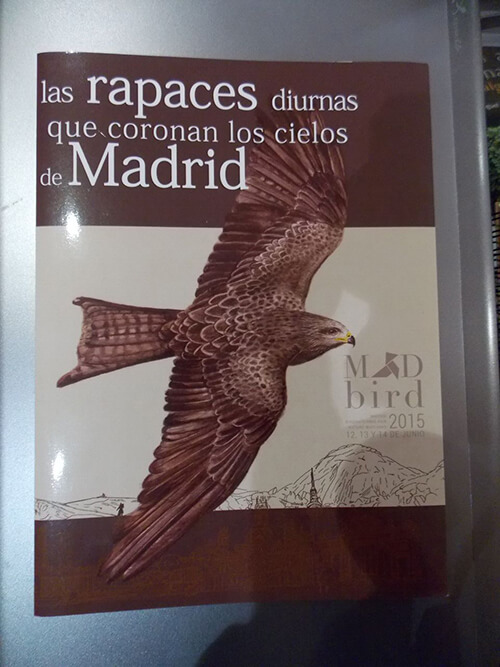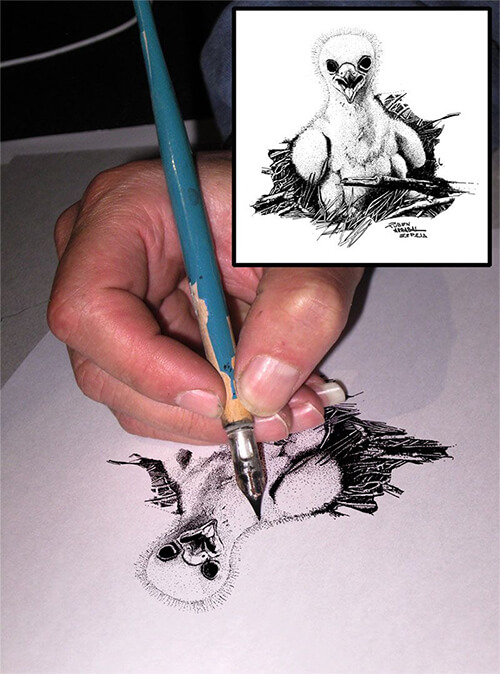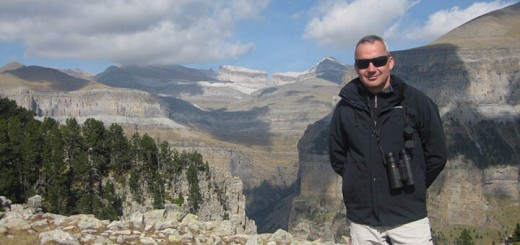A male bustard shows off as the Eurasian Stone-curlew fixes its eyes on us. Above our heads, a vulture spreads its wings while, from the top side of a nest box, a tit looks astonished at a European Green Woodpecker. Several birds of prey and other smaller birds parade ahead of us. These are all examples of realistic scale models, regarding texture and colour, which are being manufactured since 2004 in the workshop of the company Rubén Artes Plásticas, located in Tubilla de Lago, in the province of Burgos.
But there is more to it. This artist works enthusiastically with all kinds of mediums and formats. We are surprised by the images of great realism of his colour drawings. The flying owl about to perch is truly amazing. With his ink drawing he shows us the great variety of details that can be gathered by the retina of an expert.
We are highly impressed by the perched Golden Eagle that shows the greatness of the queen of the skies. Digital drawing incorporates new technologies to his work in order to increase creative possibilities. The results with the male bustard and the Little Owl are really impressive. This enthusiast of visual arts also masters the technique in murals and graphic design. He doesn’t forget to create new manipulatives or to prepare spectacular scenographies and decorations. He is a real expert who surprised us during the last Madrid Bird Fair with the triptych “Diurnal birds of prey that conquer the skies of Madrid”. This has become a real guide for us and we have used it from time to time to identify birds in flight. After contacting him, today we exclusively offer you an interview where we would like not only to introduce the artist, but also to unveil the naturalist inside him.
- Question: We have read that during your childhood you used to travel the lands of Aranda de Duero, in Burgos, with your binoculars and a notepad, looking for adventure. But how does your interest for drawing and painting start?
- Answer: I think that is something that has always been there but, when I really started taking drawing and painting seriously, it was partially out of necessity. In the 1980s we started with the naturalist association A.F.F.A. (friends of native wildlife, after its Spanish initials). The edition of a newsletter and the different campaigns being carried out forced us to include nature drawings. At this point is when one gradually gains experience and technique until now, when the association no longer exists, but I keep drawing both for personal fulfilment and on request.
- Question: Some bird and nature drawers take pictures as a model, while others opt for direct observation and they carry out their work in situ. Which drawing or painting technique do you prefer in order to express yourself?
- Answer: My drawings, as you can see, are quite detailed, which makes it very hard to achieve this result from an animal that is in constant movement. For this reason, I usually base my work more in pictures I take during my long field days than in direct observation. However, the arrangements are always based in places and spaces that are kept in my mind.
- Question: In connection with the previous question, when you are drawing, is it important to define which action the animal is taking in order to integrate it in the moving scene in the most natural way or is it better to find an artistic pose?
- Answer:It depends on the work and what you want or you need to express. If the animal is not the only protagonist, it can be placed in a moving scene; if it is the protagonist, I usually look for the most attractive or interesting position for my liking. This is the same as in model photography, where you look for the most attractive postures for the viewer.
- Question: Bird painting and drawing have an overwhelming success both in the centre and in the north of Europe, while in Spain they almost go unnoticed. What do you think is the reason for that?
- Answer:Ornithological culture, which is more rooted abroad than in Spain. Here there’s still the idea that watching birds is a childhood thing and that you need to stop it when you grow up. That’s what happened to me: I was always told to leave those issues, that I was old for that nonsense. But you gradually enter the circle and there is increasingly more people who get closer to this world, especially the new generations, which have more environmental concerns.
- Question: Among your artwork, the ones that have impressed us the most are scale models, which show a great realism, the beauty of the drawings or the possibilities and results of digital drawing. Which one do you consider to be the most important of your workpieces? Which one are you most proud of?
- Answer: I don’t know what to tell you, as for me they are all equally important. Each one is different and I do all of them with the same devotion. As I usually say, they are “my children”, and when I need to get rid of them, I say I am sending then to college to take care of themselves because they are already independent hehehe. Joking aside, it usually happens that, when I create something new, I focus on it so much that I forget about the previous work, and I always try to improve the previous one, so at that point, when I finish a work piece it is usually my favourite, until I start a new one. In conclusion, all of them are equally important and favourite to me.
- Question: At this point of the interview, can you advance which projects do you have in mind?
- Answer: Ugh, I have so many. But a lot of them are dreams that I would like fulfil someday, although they are not urgent now, nor is it the moment. The most ambitious is creating a touring exhibition of some of my artwork focused on Iberian fauna.
- Question: We would like to tell you that, in our opinion, one of your most renowned pieces of digital drawing, and the one we like the most, is the logo of the wildlife rescue team. How did you create this logo?
- Answer: It was an order by our GREFA friends, where there had to be emblematic animals from the Iberian Peninsula. It has been created using technological resources. Among the species, we integrated the silhouette of the Cinereous Vulture against the sun, which is the anagram of the association. It is always interesting to cooperate with nature-related teams.
- Question: From our blog, the ideas focused on the education of future generations always get our attention. We find interesting the mechanism of a gadget created for children to learn how to draw birds. How did the idea of this manipulative emerge?
- Answer: In the age of digital technology, it seems that we forget about old playing inventions. I love transferring those gadgets to the manipulatives and games associated with environmental learning. Most of them are games from our elderly that are getting lost in time. This is a pantograph, which is used to replicate drawings of a small size into bigger ones and vice versa. Others are inventions we create to play different roles according to the different needs and solutions.
- Question: At the peak of this interview, we would like to challenge you and ask you to dedicate some simple strokes of your favourite bird to our readers.
0 por Rubén Arrabal
- From these lines we want to thank the kindness and the time Rubén Arrabal has devoted to us. Thank you for the feast for the eyes that is your artwork. We hope we can come by your workshop in Burgos someday to share for a few moments the enthusiasm and the experience of the preparation of your work.
- Answer: From my modest workshop, I also thank you for the courtesy of contacting us and counting on our presence in a blog that we wish has a prosperous future and keeps being an online window to nature.















